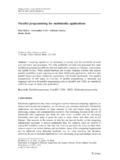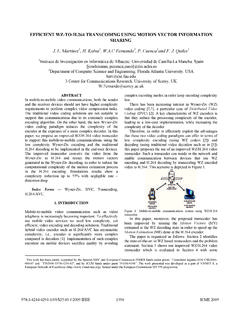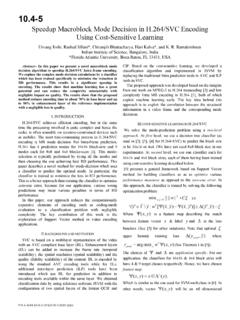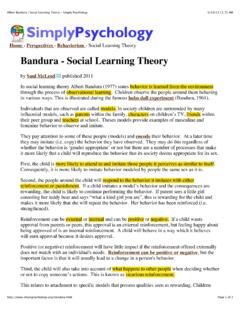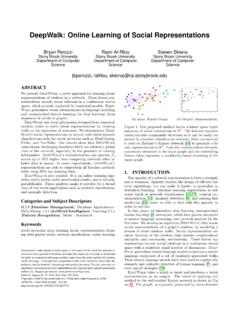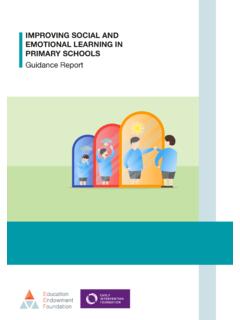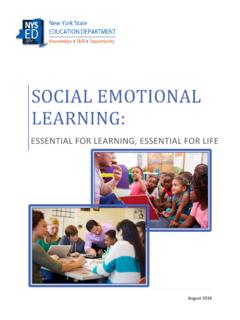Transcription of DeepWalk: Online Learning of Social Representations
1 DeepWalk: Online Learning of Social Representations Bryan Perozzi Rami Al-Rfou Steven Skiena Stony Brook University Stony Brook University Stony Brook University Department of Computer Department of Computer Department of Computer Science Science Science {bperozzi, ralrfou, ABSTRACT 12. 14 20 5. 22. 1 22. 17. 1031 18. 7 6. We present DeepWalk, a novel approach for Learning la- 18. 6 11. 21 15 23 9. [ ] 27 Jun 2014. 4 28. 21 11. 19 12. 20. 2. 7. 16 29 3 17. 15 31. tent Representations of vertices in a network. These latent 16. 9. 8. 1. 5. 33. 3428. 32. 13. 14. 27. 24. Representations encode Social relations in a continuous vector 23 33. 4 30. 34 3. 19 13. 10. space, which is easily exploited by statistical models. Deep- 27. 30. 29. 32. 24. Walk generalizes recent advancements in language mod- 28. 26 25. eling and unsupervised feature Learning (or deep Learning ) 26.}
2 25. from sequences of words to graphs. (a) Input: Karate Graph (b) Output: Representation DeepWalk uses local information obtained from trun- cated random walks to learn latent Representations by treat- Figure 1: Our proposed method learns a latent space rep- ing walks as the equivalent of sentences. We demonstrate resentation of Social interactions in Rd . The learned rep- DeepWalk's latent Representations on several multi-label resentation encodes community structure so it can be eas- network classification tasks for Social networks such as Blog- ily exploited by standard classification methods. Here, our Catalog, Flickr, and YouTube. Our results show that Deep- method is used on Zachary's Karate network [44] to gen- Walk outperforms challenging baselines which are allowed erate a latent representation in R2.
3 Note the correspon- a global view of the network, especially in the presence of dence between community structure in the input graph and missing information. DeepWalk's Representations can pro- the embedding. Vertex colors represent a modularity-based vide F1 scores up to 10% higher than competing methods clustering of the input graph. when labeled data is sparse. In some experiments, Deep- Walk's Representations are able to outperform all baseline methods while using 60% less training data. ommendation [11], anomaly detection [5], and missing link DeepWalk is also scalable. It is an Online Learning algo- prediction [22]) must be able to deal with this sparsity in rithm which builds useful incremental results, and is trivially order to survive. parallelizable. These qualities make it suitable for a broad In this paper we introduce deep Learning (unsupervised class of real world applications such as network classifica- feature Learning ) [2] techniques, which have proven success- tion, and anomaly detection.
4 Ful in natural language processing, into network analysis for the first time. We develop an algorithm (DeepWalk) that Categories and Subject Descriptors learns Social Representations of a graph's vertices, by mod- [Database Management]: Database Applications eling a stream of short random walks. Social representa- - Data Mining; [Artificial Intelligence]: Learning ; tions are latent features of the vertices that capture neigh- [Pattern Recognition]: Model - Statistical borhood similarity and community membership. These la- tent Representations encode Social relations in a continuous 1. INTRODUCTION vector space with a relatively small number of dimensions. DeepWalk generalizes neural language models to process a The sparsity of a network representation is both a strength special language composed of a set of randomly-generated and a weakness.
5 Sparsity enables the design of efficient dis- walks. These neural language models have been used to crete algorithms, but can make it harder to generalize in capture the semantic and syntactic structure of human lan- statistical Learning . Machine Learning applications in net- guage [6], and even logical analogies [28]. works (such as network classification [15, 37], content rec- DeepWalk takes a graph as input and produces a la- tent representation as an output. The result of applying our method to the well-studied Karate network is shown in Fig- ure 1. The graph, as typically presented by force-directed layouts, is shown in Figure 1a. Figure 1b shows the output of our method with 2 latent dimensions. Beyond the striking similarity, we note that linearly separable portions of (1b). c The authors, 2014. This is the author's draft of the work.)
6 It is posted here correspond to clusters found through modularity maximiza- for your personal use. Not for redistribution. The definitive version was published in KDD'14, tion in the input graph (1a) (shown as vertex colors). 2623732 To demonstrate DeepWalk's potential in real world sce- narios, we evaluate its performance on challenging multi- In the literature, this is known as the relational classifi- label network classification problems in large heterogeneous cation (or the collective classification problem [37]). Tradi- graphs. In the relational classification problem, the links be- tional approaches to relational classification pose the prob- tween feature vectors violate the traditional assump- lem as an inference in an undirected Markov network, and tion. Techniques to address this problem typically use ap- then use iterative approximate inference algorithms (such proximate inference techniques [31, 35] to leverage the de- as the iterative classification algorithm [31], Gibbs Sam- pendency information to improve classification results.)
7 We pling [14], or label relaxation [18]) to compute the posterior distance ourselves from these approaches by Learning label- distribution of labels given the network structure. independent Representations of the graph. Our representa- We propose a different approach to capture the network tion quality is not influenced by the choice of labeled ver- topology information. Instead of mixing the label space tices, so they can be shared among tasks. as part of the feature space, we propose an unsupervised DeepWalk outperforms other latent representation meth- method which learns features that capture the graph struc- ods for creating Social dimensions [39, 41], especially when ture independent of the labels' distribution. labeled nodes are scarce. Strong performance with our rep- This separation between the structural representation and resentations is possible with very simple linear classifiers the labeling task avoids cascading errors, which can occur in ( logistic regression).
8 Our Representations are general, iterative methods [33]. Moreover, the same representation and can be combined with any classification method (in- can be used for multiple classification problems concerning cluding iterative inference methods). DeepWalk achieves that network. all of that while being an Online algorithm that is trivially Our goal is to learn XE R|V | d , where d is small num- parallelizable. ber of latent dimensions. These low-dimensional represen- Our contributions are as follows: tations are distributed; meaning each Social phenomena is expressed by a subset of the dimensions and each dimension We introduce deep Learning as a tool to analyze graphs, contributes to a subset of the Social concepts expressed by to build robust Representations that are suitable for the space. statistical modeling.
9 DeepWalk learns structural reg- Using these structural features, we will augment the at- ularities present within short random walks. tributes space to help the classification decision. These fea- tures are general, and can be used with any classification We extensively evaluate our Representations on multi- algorithm (including iterative methods). However, we be- label classification tasks on several Social networks. We lieve that the greatest utility of these features is their easy show significantly increased classification performance integration with simple machine Learning algorithms. They in the presence of label sparsity, getting improvements scale appropriately in real-world networks, as we will show 5%-10% of Micro F1 , on the sparsest problems we con- in Section 6. sider. In some cases, DeepWalk's Representations can outperform its competitors even when given 60% less training data.
10 3. Learning Social Representations . We seek Learning Social Representations with the following We demonstrate the scalability of our algorithm by characteristics: building Representations of web-scale graphs, (such as YouTube) using a parallel implementation. Moreover, Adaptability - Real Social networks are constantly we describe the minimal changes necessary to build a evolving; new Social relations should not require re- streaming version of our approach. peating the Learning process all over again. Community aware - The distance between latent The rest of the paper is arranged as follows. In Sections 2. dimensions should represent a metric for evaluating and 3, we discuss the problem formulation of classification Social similarity between the corresponding members in data networks, and how it relates to our work.


